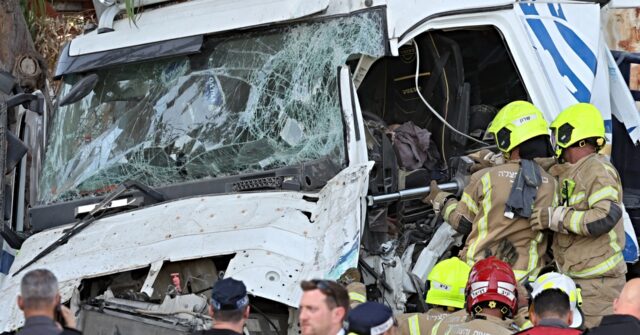On a fateful Sunday in central Israel, a truck driver launched a deliberate attack, driving his vehicle into a crowd at a bus stop, resulting in the tragic death of one individual and injuries to at least 36 others, with six suffering serious injuries. This shocking incident unfolded near the Glilot military base—home to Israel’s renowned 8200 intelligence unit—markers of a location previously targeted by groups such as Hezbollah and Iranian forces. Eyewitness accounts and preliminary police investigations indicate that the truck not only struck pedestrians but also collided with a bus that had temporarily halted to drop off passengers. In a show of resilience and urgency, bystanders intervened; they managed to subdue the driver before ambulances could arrive, demonstrating a collective effort in an age of escalating violence.
Following the incident, Hamas claimed responsibility for the attack, framing it as a retaliatory act born from Israel’s aggressive actions in Gaza, the West Bank, and Jerusalem. The attack occurred at Aharon Yariv Boulevard in Ramat HaSharon, situated to the north of Tel Aviv’s bustling commercial district. The group’s declaration hints at the underlying tensions characterizing Israeli-Palestinian relations, alongside the broader geopolitical clashes affecting the region. Magen David Adom (MDA), Israel’s emergency service, confirmed that out of the 36 injured, 16 were transported to nearby hospitals for urgent medical attention, underscoring the critical nature of the situation amidst the chaos.
Scenes from the site of the attack were harrowing; local authorities swiftly responded as officers and ambulances flooded the area, while news coverage depicted police cordoning off the zone where the heinous act occurred. Medics worked tirelessly to assist the injured, with a helicopter hovering above—a visual representation of the gravity of the emergency. This tragic event unfolded on the very day when Israel was engaged in solemn ceremonies commemorating the anniversary of Hamas’s terrorist assault on October 7 of the preceding year, which sowed the seeds for ongoing hostilities in Gaza and Lebanon.
In the aftermath of such violence, security concerns have escalated in Israel, especially in light of recent events that serve as stark reminders of the risks civilians face daily. The truck attack exemplifies the alarming trend of increased aggression, prompting national discussions on security measures and public safety protocols. The Israeli government, led by National Security Minister Itamar Ben-Gvir, inspected the scene while emphasizing the need to address underlying issues fuelling these aggressive acts. The realities of ongoing conflict demand attention not only to immediate security responses but also to broader dialogue aimed at reconciliation and understanding.
The ramifications of the attack extend beyond the physical toll on victims and their families, encompassing the psychological impact on a nation that continuously grapples with the specter of terrorism. Communities across Israel face heightened anxiety as often unpredictable violence forces a re-evaluation of safety measures in public spaces. Moreover, the timing of the incident, coinciding with significant anniversaries, adds a layer of emotional exhaustion to the populace, which must confront not only the reality of frequent violence but also the memories of past tragedies.
As Israel, and the broader region, continues navigating this tumultuous landscape, it becomes increasingly essential for leaders to adopt multi-faceted strategies to combat not only the symptoms of such violence but also its root causes. Addressing the cycle of retaliation, fostering dialogue between conflicting groups, and promoting grassroots peace initiatives must be prioritized to pave the way for a more secure and peaceful existence. The incident at the Glilot military base stands as a grim reminder of the enduring conflict’s human toll, nudging both local and international communities towards seeking sustainable solutions to blight the cycle of violence prevalent in the region.

